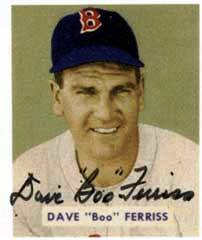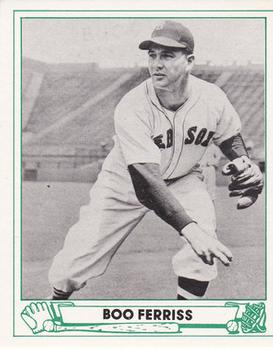May 23, 1945: Boo Ferriss beats Browns for fifth straight win
 Dave “Boo” Ferriss, an ex-GI discharged from the Army Air Corps in February 1945, began his major-league career with an astonishing eight consecutive wins in
Dave “Boo” Ferriss, an ex-GI discharged from the Army Air Corps in February 1945, began his major-league career with an astonishing eight consecutive wins in 1945. The start of his career was unprecedented, since Ferriss had minimal time as a professional player prior to his major-league debut with the Boston Red Sox.1 All of his first four starts were complete games and three of them were shutouts. Ferriss pitched a record 22⅓ consecutive scoreless innings.
1945. The start of his career was unprecedented, since Ferriss had minimal time as a professional player prior to his major-league debut with the Boston Red Sox.1 All of his first four starts were complete games and three of them were shutouts. Ferriss pitched a record 22⅓ consecutive scoreless innings.
With several stars, including future Hall of Famers Ted Williams and Bobby Doerr, away in military service, the Red Sox were in the AL cellar going into the game on May 23. In their most recent series, they had lost three of four games to the Chicago White Sox. Manager Joe Cronin blamed the losses on the team being idled because of four consecutive rainouts in St. Louis on May 14-17.2
The defending American League champion Browns were making the trip into Fenway Park in third place. The team featured Pete Gray, a one-armed outfielder who had made the Browns’ roster largely due to the shortage of players during the war. The Browns’ Sig Jakucki (2-2), a former Army private, drew the starting assignment against Ferriss, an ex-soldier who had served 26 months in the Army Air Corps before being discharged because of a bad case of asthma.
The Red Sox jumped out on top in the first inning when Ben Steiner walked, went to third on a hit by Johnny Tobin, and scored on a force-play grounder by Bob Johnson.
The Red Sox added two runs in the fourth inning on singles by Bob Garbark, Ferriss, and Steiner. Ferriss extended his consecutive-game hit streak to five, while Garbark went 4-for-4 in the game. The Red Sox added a final run in the eighth inning on a walk, a sacrifice, a single and Ferriss’s fly ball.
Ferriss scattered a walk and two singles through six scoreless innings. He gave up a double to Mike Kreevich to lead off the seventh, and Kreevich scored on a single by Gene Moore, ending ending another string of 17 scoreless innings by Ferriss.
Ferriss gave up five hits and one base on balls, while striking out two in the 4-1 victory, his fifth consecutive. Pete Gray was hitless in four at-bats against the right-hander.
The Red Sox’ record was now 10-15, with Ferriss responsible for half of their wins.
Ferriss continued his reputation for being a steady hitter, and so far had three pinch-hit plate appearances. With his 1-for-4 hitting performance in this game, the left-handed hitter’s batting average was a hefty .471.
In addition to his pitching, Ferriss had some background as a position player before reaching the majors. He had played first base for Mississippi State College and the outfield on his Army service team at Randolph Field in Texas. When the organizers of a scheduled July 10 war relief fund benefit game between the Red Sox and Boston Braves at Fenway Park were putting together their program, they suggested that Ferriss pitch the first three innings, play first the next three, and play the outfield the final three.3 It was a testament to Ferriss’s growing popularity in Boston.
Ferriss won 21 games for the Red Sox in 1945. Many observers surmised that his success was due in large part to having faced weak opposing lineups because of the shortage of experienced players during the war.
However, Ferriss proved he was no fluke by winning 25 games in 1946 when most prewar players had returned. He led the American League with a winning percentage of .806, while helping the Red Sox to their first pennant since 1918.
Ferriss’s career was cut short by an arm injury suffered during the 1947 season. He made only nine major-league starts from 1948 to 1950.4He was the pitching coach for the Red Sox from 1955 to 1959. Despite his shortened career, he was elected to the Red Sox Hall of Fame in 2002.
Sources
In addition to the sources mentioned in the Notes, the author also consulted the Baseball-Reference.com and Retrosheet.org websites; Marc Z. Aaron’s and Bill Nowlin’s Who’s on First: Replacement Players in World War II (Phoenix: Society for American Baseball Research, 2015); Rick Cleveland’s Boo: A Life in Baseball, Well-Lived (Battle Ground, WA: Pediment Publishing, 2008); David Pietrusza’s, Matthew Silverman’s, and Michael Gershman’s Baseball: The Biographical Encyclopedia (New York: Total/Sports Illustrated, 2000); and Roger Birtwell’s “Ferriss Wins Fifth Straight, Braves Buy Mort Cooper,” Boston Globe, May 24, 1945.
Notes
1Prior to his major league debut, Ferriss’s minor-league career consisted solely of 130 innings with Greensboro of the Class B Piedmont League in 1942, when Ferriss was age 20. He was in military service in 1943 and 1944, then got off to his remarkable start in 1945 as a major-league rookie
2Hy Hurwitz. “Ferriss Goes After Fifth Win: Gray Plays With Browns Here,”Boston Globe, May 23, 1945: 15.
3 “Spang Heads Boston Program,” The Sporting News, May 17, 1945: 16.
4 Ferriss finished his playing career at AAA Louisville, where he was a combined 14-12 in 1951 and 1952.
Additional Stats
Boston Red Sox 4
St. Louis Browns 1
Fenway Park
Boston, MA
Box Score + PBP:
Corrections? Additions?
If you can help us improve this game story, contact us.


